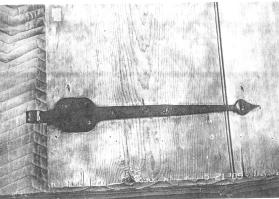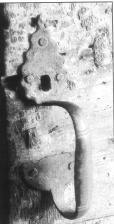HVVA
NEWSLETTER, June 2005
(Click
on graphics/photos for larger view)
HVVA Newsletters
Part Two
From the Editor
I received some information on local hinges from
Fr:ank White, of Lebanon, New Jersey, whom we had met last winter
when HVVA visited the Voght House in Clinton Township, Hunterdon County,
NJ. (see Newsletter Vol. 7, No 2.). That 18th century German stone
house with decorative plaster ceilings is still being protected by
the State of New Jersey as a historically significant building against
its planned destruction by the local public school but so far no use
has been found or group has yet adopted it.
Frank sent me pictures of strap hinges from two
doors from houses in Clinton Township, NJ. The one illustrated here
is associated with a 1735 house in a Dutch settlement in Readington.
The other was from a 1750 Palatine German house. He wanted to know
if I had ever seen a hinge pad like that on the 1735 Dutch house.
I began to document what I think are the early hinges of the Palatine
Farmstead House circa 1740, in Rhinebeck, New York, and was surprised
to find a similar but more refined example on the remains of a three-batten
cellar. door. In this case the hinge has a soft-arrow finial.
 Strap
Hinge from a circa 1735 DutchlIouse Readington, -->
Strap
Hinge from a circa 1735 DutchlIouse Readington, -->
Clinton Township, Hunterdon County, New Jersey
 <-Strap
Hinge from the Cellar Door of the circa 1740 Palatine Farmstead House
Rhinebeck, Dutchess County, New York. (ny/du/rh/0020). This Dutch
pad hinge with a soft-arrow finial has a similar nailing pattern to
the Readington, New Jersey, example. The wooden batten to which it
is nailed is from a later enlargement and reconstruction of the door.
<-Strap
Hinge from the Cellar Door of the circa 1740 Palatine Farmstead House
Rhinebeck, Dutchess County, New York. (ny/du/rh/0020). This Dutch
pad hinge with a soft-arrow finial has a similar nailing pattern to
the Readington, New Jersey, example. The wooden batten to which it
is nailed is from a later enlargement and reconstruction of the door.
Strap Hinge from the. Kitchen Door, Palatine Farmstead,
Rhinebeck.
 <-This strap hinge is on the door of the kitchen added to the 1790
house but reconfigured from an earlier construction. The hinges are
encrusted with paint but their classic Dutch form is visible. Today
people of The Valley are proud of their old Dutch doors and hardware.
The hinges and latches are usually painted black to emphasize them
but in the 18th century they were not painted a separate color.
<-This strap hinge is on the door of the kitchen added to the 1790
house but reconfigured from an earlier construction. The hinges are
encrusted with paint but their classic Dutch form is visible. Today
people of The Valley are proud of their old Dutch doors and hardware.
The hinges and latches are usually painted black to emphasize them
but in the 18th century they were not painted a separate color.
Suffolk Latch from the Possible 1740 Front Door Palatine
Farmstead, Rhinebeck.
 This latch has been renailed to the reused false panel door. It has
a Pennsylvania German look and its method of attachment is unique.
This latch has been renailed to the reused false panel door. It has
a Pennsylvania German look and its method of attachment is unique.
On the remains of a reused false-panel door, that
may have been the front-door to the original circa 1740 Rhinebeck
house, there is the imprint of a missing pad hinge with a pointed
finial. The cellar door and the false panel door have the same molding
profile and so appear contemporary. It seems that the cellar hinge
was given an earlier more Dutch style finial while the front door
adopts a more English style finial. A door into the early undated
kitchen addition has small pad hinges with soft arrow finials.
The decorative Suffolk latch that has survived on
the 1740 front door of the Palatine House in Rhinebeck is very unique.
Of the 198 Suffolk latches illustrated in Earlv American WrouS!ht
Iron, 1979 edition, by Albert H. Sonn, none has the bottom plate turned
up as this example does. Perhaps this was done later when the latch
was renailed to the door. The decorative feature of the top pad has
a German look.
 <-Finally
the remains of a three-batten door were found in the 1770 barn at
the Palatine farmstead in Rhinebeck. It might have been an animal
door. The surviving hinge has a pointed finial and a round pad.
<-Finally
the remains of a three-batten door were found in the 1770 barn at
the Palatine farmstead in Rhinebeck. It might have been an animal
door. The surviving hinge has a pointed finial and a round pad.
Strap Hinge from the 1770 Dutch Barn Palatine Farmstead,
Rhinebeck." This  hinge
from a door fragment found in the barn has adopted a pointed finial.
The door is particularly well made with 1.26-inch splines joining
the three vertical boards.
hinge
from a door fragment found in the barn has adopted a pointed finial.
The door is particularly well made with 1.26-inch splines joining
the three vertical boards.
The holes are rectangular and the hinge is nailed
with the same hand-forged T-headed nails used to construct the door.
Despite the distance from Clinton Township, NJ,
to Rhinebeck, Dutchess County, NY, close to 100-miles, in the 18th
century their strap hinges were made pretty much the same, be it for
a Dutch or a Palatine German family.
HVVA MEETING.................................................
Maggie MacDowell, Secretary
Saturday, June 4, 2005 The meeting was opened at 10:30 AM, by Vice
President, Jim Decker at the Marbletown Firehouse. Eleven members
attended (*)
Old Business... Rob is in contact with Emily Benson for TV
filming of door installation. Johnathan Nedbor is forging the hardware.
The filming will take three days.
Tour....The Marbletown fundraising tour was discussed again
but it was agreed that we should not pursue it but rather look toward
increased membership. Rob will work toward producing a new brochure
and suggested a promotion and membership committee be formed. George
suggested we set up a table at the coming Stone House Day in Hurley.
The Survey ..... Peter reported that it is underway and he
has been working to organize Dutchess and Ulster Counties. a number
of people are expressing interest in working on their towns. The forms
are not yet on-line but copies of present working forms were distributed
for input.
Barn Workshop ....Peter reported that it was a great success
and a volunteer day is being planned to do siding and plan its future.
The barn Fund is down to $78. We will need to raise money to do further
timber repair.
New Business....... lt was agreed that we need a $200 to $300
global positioning devise (GPS) for work on the survey. "
Orange County ......The Edmundson House in New Windsor has
asked that we have a meeting at their site and we will plan for a
third Saturday, September 17, there.
Meeting Time.......lt was discussed and unanimously agreed
that we return to our old meeting schedule of the third Saturday of
each month The meeting was adjourned at 11 :30 AM.
(*)Jim Decker, Bob Eureck, Maggie MacDowell, Karen Markinsenis, Betty
Mosny, George van Sickle, Peter Sinclair, John & Marion Stevens,
Rob Sweeney and Dennis Tierney.
Copyright
© 2005.
Hudson Valley Vernacular Architecture. All rights reserved. All
items on the site are copyrighted. While
we welcome you to use the information provided on this web site
by copying it, or downloading it; this information is
copyrighted and not to be reproduced
for distribution, sale, or profit.